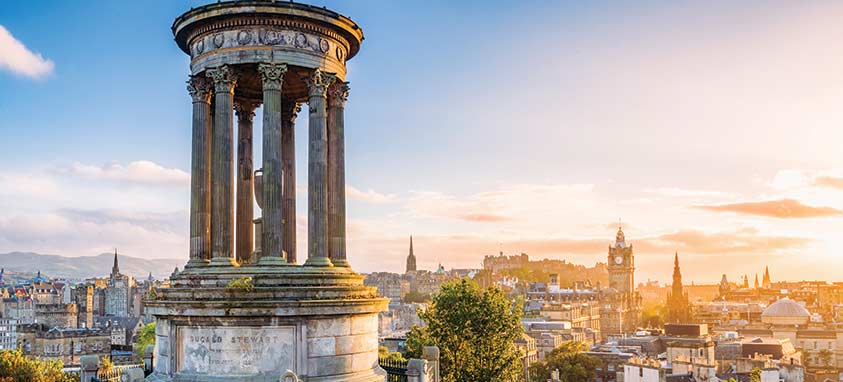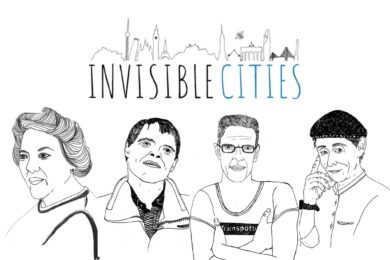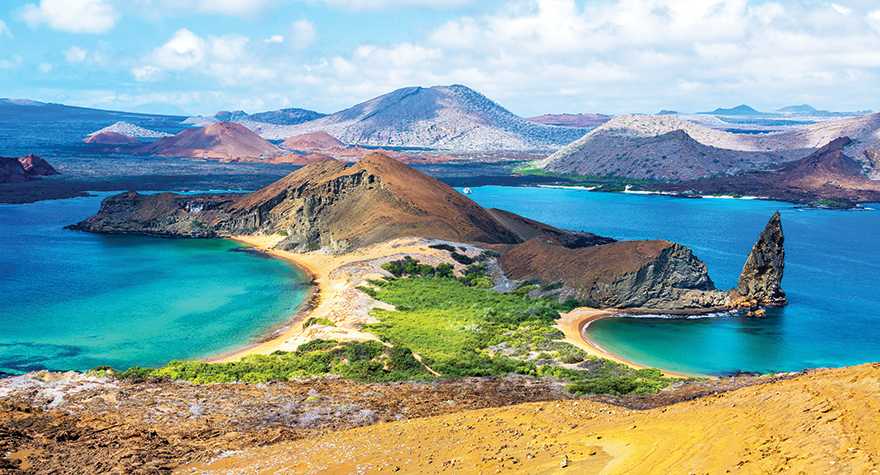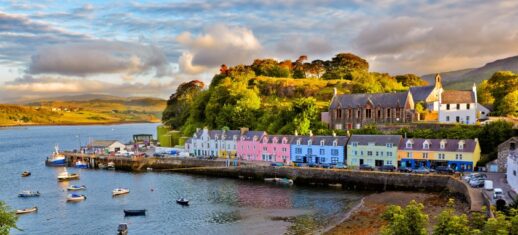Dugald Stewart Monument, Edinburgh
Top UK cities offer rich history, exciting new hotels and attractions
Ever since the United Kingdom was established in 1901, there have been many claims and heated discussions over which of its cities should be considered the second most important, after London.
Over the years, the English cities of Manchester and Birmingham, as well as Scotland’s Glasgow and Edinburgh, are among the many that have strongly vied for the distinction, and each can make a case for deserving it today. All of them boast a fascinating history and have played major cultural, political and economic roles in the U.K.
Along with ever-popular London, these cities also are among the top meeting cities in the U.K. The American Express Global Business Travel annual report showed that in 2015, all five cities (along with Aberdeen, Scotland, and Dublin) were among the seven leading U.K. cities for business travel.
The five cities have retained their rich history while constantly evolving to better address the changing needs of meeting groups. This fluidity has facilitated the creation of new conference centers, hotels and attractions, which are boosting the number of meetings and participants to unprecedented heights—and much more is in the works.
Smart Meetings provides a glimpse at each of these cities and their exciting recent developments.
Edinburgh: Dynamic Capital City
 Hilton Edinburgh Carlton
Hilton Edinburgh Carlton
Scotland’s capital city, Edinburgh, continues to gain popularity as a meetings destination. Last year was the city’s most successful on record and this year, 206 new events were confirmed, which will bring more than 74,000 attendees, an increase of 10,000 over last year.
“As a meeting destination, Edinburgh has it all,” says Lesley Williams, head of business tourism for Convention Edinburgh. “Scotland’s beautiful and dynamic capital city, with its rich, historical roots, seamlessly blends with a modern and international flavor. Whether it’s finance, science or creative industries, it is a city thriving with bright minds and innovative research and development.
“This makes it a natural choice for meetings, conventions and conferences. Event organizers can choose from majestic to creative, large, purpose-built conference facilities; luxury castles; stately homes; art galleries and museums; underground caves; whisky vaults; and even a Royal yacht.”
Many of Edinburgh’s outstanding features can be viewed during Rabbie’s City Tours excursions, which were launched this summer. During a mini-coach tour of the entire UNESCO World Heritage Center area, groups learn about celebrated locals, majestic castles and historic structures, such as Dugald Stewart Monument.
Edinburgh’s meetings portfolio is being enhanced by three new projects. Carlton Hotel underwent a $23.9 million transformation this year and emerged as Hilton Edinburgh Carlton. The project increased the guest rooms to 211 and added an executive lounge, and a new restaurant and bar. All meeting and event spaces were revamped, and accommodate up to 300 attendees.
A luxury refurbishment and extension of Georgian townhouses next to Edinburgh Playhouse resulted in the creation of Courtyard Edinburgh, a 240-room, four-star hotel with a restaurant and 431 sq. ft. of meeting space.
In April, Royal College of Physicians of Edinburgh began a $10.6 million renovation of its conference center, meeting rooms and Sir John Crofton Room. The centerpieces will be a state-of-the-art 300-seat auditorium and a spectacular glass atrium that links the historic and modern buildings.
Glasgow: Ancient, Yet Modern
 Scottish Exhibition and Conference Centre, Glasgow
Scottish Exhibition and Conference Centre, Glasgow
Glasgow sits in an area of Scotland that has been settled since prehistoric times, and Glasgow University is the fourth oldest university in the world. So, the city is saturated in history, but don’t think for a second that it’s stuck in the past.
On the contrary, Glasgow keeps on moving forward, not only staying attuned to the times, but often setting the pace. This is seen in the city’s proactive approach to sustainability. Last year, Glasgow became the first U.K. city to join the Global Destination Sustainability Index.
“‘Glasgow’ means ‘dear green place,’ in old Scots [the old Scottish language], and this has never been more true,” says Aileen Crawford, head of conventions for Glasgow City Marketing Bureau. “The city is at the center of low carbon and renewable businesses in Scotland.”
The city’s progress also is reflected in a new wave of development that includes significant hotels and entertainment venues.
 The Flying Scotsman at The Corinthian Club, Glasgow
The Flying Scotsman at The Corinthian Club, Glasgow
A $40 million Radisson Red will open in 2017 on the banks of River Clyde, in the middle of Glasgow’s entertainment hub. It will be next to Scottish Exhibition and Conference Centre (SECC), Scotland’s largest exhibition center, with 240,000 sq. ft. of event space. The hotel will also offer 176 guest rooms, 1,076 sq. ft. of meeting space, a restaurant, a bar and a gym.
Scheduled to open in late 2016, DoubleTree by Hilton Hotel Glasgow Central will be situated in the heart of the city, near famous Glasgow City Chambers, iconic Glasgow Cathedral and SECC. It will have 300 guest rooms and 39,172 sq. ft. of meeting space, including an 11,349-square-foot ballroom, the largest in the country.
The Corinthian Club, a converted courthouse and bank located in Glasgow City Centre, is the city’s most stylish dining, casino gaming and late-night clubbing venue. Ideal for social gatherings, it has 8,611 sq. ft. of event space. The Flying Scotsman, a brand-new concept at the five-story club, features architectural elegance, a vaulted auditorium, overlooking balconies and private dining rooms.
London: UK’s Main Hub Keeps Evolving
 Eighteen Sky Bar at InterContinental London-the O2
Eighteen Sky Bar at InterContinental London-the O2
Unquestionably the principal city in the United Kingdom, London attracts visitors from throughout the world both because of its wealth of historical attractions—including Tower of London, Buckingham Palace and British Museum—but also because it continues to rapidly evolve.
“London is one of the most popular destinations in the world, and we forecast that the city will welcome 35 million visitors [annually] by 2020,” says Chris FJ Lynn, vice president of business tourism in the North American and emerging markets for London & Partners. “But the city isn’t resting on its laurels, and keeps improving its infrastructure.”
The Night Tube, which began operating in August, is a 24-hour service on the London Underground system (commonly called “the Tube”) designed for late-night travelers on Fridays and Saturdays. The Tube is also being extended in the Nine Elms area, southwest of Westminster, where the new U.S. embassy is being built and the iconic Battersea Power Station is being transformed into a mixed-use development that will include a hotel, restaurants and a business quarter.
Also, Switch House, an extension of the modern art gallery Tate Modern, London, opened in June, and is Britain’s most important new cultural center built in the past 20 years. It offers seven meeting rooms. Another Tate Modern facility, The Tanks—the world’s first gallery space for live art—recently opened, and accommodates up to 600 for special events.
After closing its London Bridge location in June, Design Museum—featuring cutting-edge exhibits on fashion, architecture, graphics, and product and digital design—is scheduled to open at the former site of the Commonwealth Institute in Kensington in late November, and will include 10,763 sq. ft. of event space.
London also has been busy opening new properties. Hilton London Bankside, situated near the popular Southbank Area, has 292 guest rooms and more than 10,000 sq. ft. of meeting space. Located on the bustling Greenwich Peninsula, the riverside InterContinental London-The O2 provides 453 guest rooms and 48,400 sq. ft. of meeting space, divided among 20 areas. The millennial-friendly M by Montcalm Shoreditch London Tech City Hotel, in the heart of East London’s Tech City, has 269 guest rooms and 4,306 sq. ft. of meeting space.
The city’s oldest hotel, Brown’s Hotel, opened the redesigned, sophisticated Kipling Suite in the spring, named after famous writer Rudyard Kipling, who penned Jungle Book while staying there. Located in the Mayfair neighborhood, the hotel has 117 guest rooms and 2,153 sq. ft. of meeting space.
London is expected to open another 16,000 guest rooms by 2018.
Birmingham: Carving an Exciting New Image
 Grand Central Birmingham (Photo by Tereza Kohutova)
Grand Central Birmingham (Photo by Tereza Kohutova)
Birmingham welcomed a record-breaking 1 million visitors last year and boasted the largest increase in overseas business visitors of any British regional city.
“Birmingham is undergoing an exciting transformation, and it’s changing the way people are looking at the city,” says Stephanie Mynett, business development manager for Birmingham Convention Bureau. “From the unveiling of the new Grand Central shopping mall to the launch of the Resorts World entertainment complex, Birmingham is a young and constantly evolving U.K. city, giving visitors plenty to explore.”
Grand Central Birmingham—located above the newly renovated New Street railway station—has been redesigned with a glass atrium roof as its centerpiece. It’s home to 66 shops and restaurants across 500,000 sq. ft. and is expected to attract 50 million visitors each year.
Resorts World Birmingham is a new leisure complex full of designer shops, stylish bars, a boutique hotel, a luxury spa and much more. It’s located on the site of the National Exhibition Centre, which boasts more than 2.1 million sq. ft. of event space.
Attractive meeting spaces are available in new hotels that recently opened in Birmingham, including Park Regis Birmingham, which emerged in March from the $65 million renovation of the Auchinleck House Building. Park Regis, a modern hotel, offers 253 guest rooms and 6,458 sq. ft. of meeting space.
This month, Holiday Inn Birmingham City Centre, a state-of-the-art conference and events center, is set to complete the first phase of a multimillion-dollar development project that will add 20 guest rooms, bringing the total to 257. The hotel provides 14,585 sq. ft. of event space, including 24 flexible meeting rooms and six event suites.
Also, the University of Birmingham has received permission to build a 172-room hotel and conference facility, to be known as Hornton Grange Hotel and Conference Center. It’s expected to open by summer 2018.
Manchester: In the Midst of a Renaissance
 Infinity pool at King Street Townhouse, Manchester
Infinity pool at King Street Townhouse, Manchester
Like Birmingham, Manchester has been booming as a meetings destination.
“Manchester’s meetings industry has been steadily gaining momentum for some time now, with our latest figures showing that business visits form the largest visitor market to Greater Manchester,” says Nick Brook-Sykes, director of tourism at Marketing Manchester. “I’d attribute this to a significant period of growth that the city’s going through. Manchester is undergoing a renaissance at the moment, with a host of new cultural attractions and property developments increasingly making the city a more attractive destination for meeting and event organizers.”
Brook-Sykes regards Manchester’s excellent transportation infrastructure as essential to this renaissance. The city is two hours from London by train and is internationally accessible via Manchester Airport (MAN), which is undergoing an expansion that will provide direct routes from San Francisco and Boston.
Plenty of new attractions have opened or expanded, as well. The Whitworth at the University of Manchester—featuring an internationally acclaimed collection of British art and exhibitions by some of the world’s leading artists—recently underwent a $20 million redevelopment that doubled its size, and now fully integrates into the surrounding park it calls home. It’s available for group gatherings.
 Hotel Football, Manchester
Hotel Football, Manchester
Hotel Football opened in March 2015 on the doorstep of Old Trafford football stadium, home of Manchester United. It provides 133 guest rooms, a cafe and more than 12,500 sq. ft. of meeting space.
Situated within the upper King Street Conservation Area of Manchester City Centre, King Street Townhouse is located in an impressive Italian renaissance building. The newly opened hotel features 40 guest rooms, an infinity spa pool and meeting space for up to 150 guests.
Smart Dispatch: A Venture into Scotland

Smart Meetings was invited to participate in a press trip to the United Kingdom in July, and to our surprise, it turned out to be an invitation to the UK Summit in Edinburgh, Scotland. The summit is a partnership between London & Partners and VisitScotland, the respective destination marketing organizations.
This was the second annual UK Summit, attended by approximately 16 North American meeting planners and 16 travel destination partners. The event, which was held in London last year, had the format of a hosted buying program July 22–23.
I flew in on Sunday, July 24, in time for the post-summit part of the trip. My group had lunch at Sheraton Grand Hotel & Spa, Edinburgh. We were then divided into two groups, with half going to London and the other half going to Scotland. I was part of the Scotland group, and one of our first stops was Stirling Castle.
It’s exactly what a castle should look like, situated on top of a hill, all by itself, overlooking the valley—no one could sneak up on it. It’s where Mary Queen of Scots spent time. King James V, who had a vision of establishing a more enlightened society, ran the country from the castle. It is a great historical site during the day and after it closes to the public, groups can arrange to use all or part of it for events at night. Gatherings come with all the usual amenities, such as catering and decor, and feature actors, musicians and demonstrations.
From Stirling Castle, we drove to Gleneagles Hotel in Auchterarder and checked in. We had predinner drinks in the wine cellar. It was very well-stocked, and my only disappointment was that I did not have a corkscrew with me. We had dinner at Deseo, a casual restaurant, where we watched a cooking demonstration for rack of lamb (in Scotland, it’s called spring lamb). Exquisite whiskey was served at The Century Bar (pictured), the property’s signature bar.
A European custom breakfast—featuring a well-stocked buffet and current popular items—was included with the room. Our first activity on Monday was with Duke, an 18-month-old yellow Labrador. Scotland is known for its outdoor activities, including hunting, and Duke is a professionally trained hunting dog.
Six staff members work at Gleneagles full-time, training dogs and falcons. For groups, the staff demonstrates how a well-trained dog can help the rest of us control our pets and have them obey. We each got a turn at getting Duke to fetch toys on command—and more impressively, to wait for commands before he ran off to get things.
From there we went to the falconry, where an assortment of eagles and hawks live, as well as peregrine falcons, which can dive up to 240 mph. The birds are available for both indoor and outdoor exhibitions, and are even available to go on a guided hunt.

We took turns holding the Harris’ hawks (pictured), native to North America. They flew to our hands and grabbed food, which was their reward. They are available for use by groups. They can fly in the indoor space, and the property has a falconry building with outdoor flying areas.
Gleneagles also has full equestrian facilities, including outdoor trails, courses for jumpers and hunters, and a full indoor equestrian arena. We got lessons in how to ride, and most of us could have become decent riders if we had been able to stay there another two or three years. The indoor riding lesson is perfect for groups, as it is in a controlled environment run by passionate professionals.
We also saw quite a few people fly-fishing, including someone getting lessons. There are many streams and rivers, as well as lakes, which offer everything from trout to salmon. Wildlife photography is a huge pastime, as well.
Gleneagles, of course, hosted the Ryder Cup in 2014. The property has multiple courses and is a huge golfing destination. A nice change from the United States is that people are encouraged to walk the course instead of using a golf cart.
The next stop on our activity tour was the skeet-shooting range. It was run by passionate professionals who offer lessons, including outings in the countryside. Skeet shooting is truly a video game come to life and much harder than it looks. I did manage to hit a few clay pigeons.
That evening, before dinner, we went on a tour of the property. The sweet spot for Gleneagles resort is the 232 guest rooms and the 41,000 sq. ft. of meeting space. We also saw the family pool and next to it, an adult pool that was separated by a glass wall, which kept the area very quiet. It was also very dark, which made it very relaxing. It contained the requisite hot tub, sauna and steam room.
At the Gleneagles golf facility clubhouse, there is a bar within the bar. It is called The Blue Bar, and it’s perfect for groups. It is intimate: The fire pit comes with a whiskey sommelier, who really explains the differences between the whiskeys.
My overall impression of Scotland is that it provides a great, quick overview of the European experience. There is plenty of history, there is great food and there are interesting people.
We also spent one night at the amazing Balmoral Hotel in Edinburgh and did a dine-around that included the Charles Hotel, a recently refurbished property where history meets the modern world. It has a hip new bar and fantastic food.
–Luc Troussieux




